Kew Church Monuments
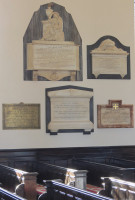
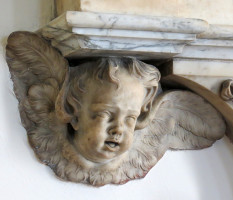
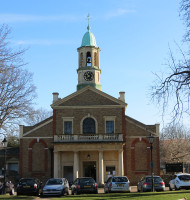
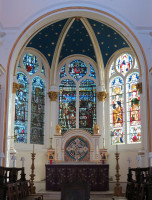
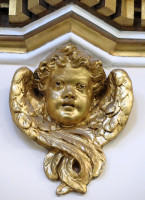

Kew Parish Church – St Anne’s Kew Green – stands close to the main entrance to Kew Gardens.
The Church contains over 30 monumental wall tablets, some with sculptural interest, and some with
botanical carving, as we would expect from the Parish church next to the most famous of all
botanical gardens. The monuments date from early in the 18th Century through to a larger group
of mid-19th Century tablets, and then on until after the First World War.
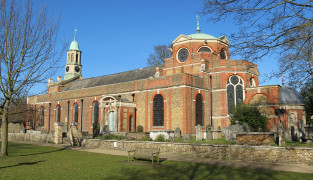 Kew Parish Church, St Anne.
Kew Parish Church, St Anne.
First a few words on the Church itself. It has a characterful and novel exterior,
reminiscent of the Greenwich observatory, especially to the visitor coming from the station,
who sees the rear of the Church, with its idiosyncratic dome, round windows below, and
round-headed arched windows all the way round – this end incorporates Chancel, mausoleum,
and extra rooms. The front end (West end), facing Kew Gardens, is more conventional (see picture at top of page):
broad Classical portico with four pillars supporting a balcony, gabled Classical upper stage,
all in brick, and the wing-like aisles projecting on either side; above is the clock and bell tower,
octagonal with a pepper-pot dome – all this part dates from the 1830s and is the apparently the work
of Sir William Wyattville, of the Wyatt family of architects and sculptors.
From the side, the Church is fairly long, eight bays in all, with round-headed windows to each bay bar
where a porch has been added. It started much shorter, in 1714, the original Church being put up by
Queen Anne, with additions in 1770 and in the early and late 19th Century.
Inside, the barrel-shaped ceiling of the nave is separated from the flat-ceilinged aisles by
tall Doric pillars, at great enough spaces that we feel in one broad space.
The main feature is the Chancel under the dome, jewel-like in its attractiveness,
with painted starry heavens above, and bright windows with Corinthian columns between.
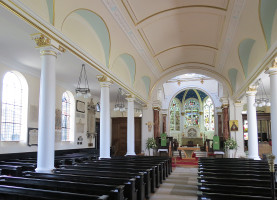
St Anne Church's bright interior.
As usual, we consider the monuments more or less in date order, but keeping those to the
Hooker and Tyrrell families altogether.
18th Century Monuments
There are seven or eight monuments from the 18th Century, all Classical panels,
including the particularly grand one to Dorothy Capell, a benefactor to the Church,
the heavily carved Baroque panel to William Douglas and at the end of the century,
that to Jeremiah Meyer with portrait and a small relief figure, and an example of an obelisk monument,
to Elizabeth Theobald.
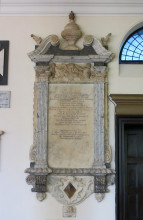 Elizabeth, Countess of Derby, d.1717.
Elizabeth, Countess of Derby, d.1717.
- Elizabeth, Countess of Derby, d.1717, put up at the same time as
the original Church,
a large monument with tall, fluted side pilasters of composite order, entablature of a cherubic head
in a cloud in front of a sunburst, with knotted drapes over it. Above, baroque swan-necked pediment,
open and broken, enclosing a pot carved with flowers. At the base, a little coat of arms is enclosed
in a cartouche of scrolling and leaves, with a grotesque head at the top.
Brackets and terminal acanthus to left and right. The whole in several shades of marble, most pleasing.
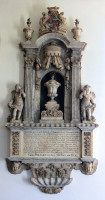
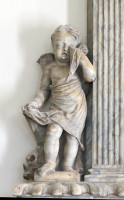
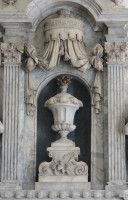
Dorothy, Lady Dowager Capell, d.1721, and details.
- Dorothy, Lady Dowager Capell, d.1721, ambitious white marble monument
centred around a funereal urn in a deep niche, canopy above with tied drapes or ribbons,
fluted pilasters to the sides, and standing, weeping cherubs outermost of all.
The pilasters support an open, curved pediment bearing the large coat of arms,
with flaming pots to each side. The inscribed panel below, itself with florally carved pilasters
to the sides, rests on a shelf beneath which is a deep apron bearing more flowers,
and with two winged cherubic heads acting as corbels.
- William Douglas, d.1747, who perished commanding the forces of Great Britain
defending the island of South Beveland. Another ambitious monument, the inscription occupying the upper
part of a panel, with ornate carved decoration covering the rest: goat’s heads to the side,
with festoons of flowers hanging from their curled horns, leading to a central Trophy –
i.e. a suit of armour with many crossed weapons behind. Beneath, the apron, enclosing the coat of arms,
is splendidly baroque in outline. Above the top shelf, a segment of a circle of too small a diameter to be a pediment
encloses a plumed helm, and above this, a small pot. See picture below left.
- Mary Russell, d.1764, panel with feet and upper shelf, with on top
an asymmetrically draped lamp of the Aladdin type.
- William Crompton, wife Sarah, and daughter
Elizabeth, without a date; the text looks pre-19th Century,
the surround – entablature, summit, shaped base, looks relatively new.
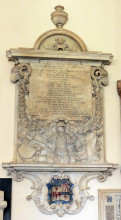
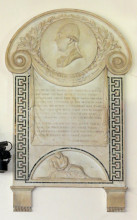 William Douglas and Jeremiah Meyer monuments, 18th Century.
William Douglas and Jeremiah Meyer monuments, 18th Century.
- Jeremiah Meyer, d.1789, a Royal Academician who painted portrait miniatures,
including in enamel. Large panel with a profile portrait in high relief at the top,
surrounded by a leafy border, and a graceful scrolled edging making a sort of swollen curved pediment.
To the sides, inlaid border with a repeating key pattern. At the base, a nice sculpture of
a reclining girl holding, or cradling rather, some draped object, probably a pot, while at the base
rest the palette and brushes of the artist; a small upturned torch completes the composition.
The girl is classically dressed, with long, flowing skirt, a cowl and lighter drapes to form the sleeves,
sensitively made, but it is the lovely oval made by her arms and clasped hands
which makes the whole so harmonious. Picture above right - you will need to click to enlarge to see it.
- William Atton, d.1793, Gardener to George III, and
William Townsend Atton, Director General of all the Royal Gardens, d.1849,
each with a poetic eulogy. Panel with high base, small pediment and a pot on top,
on a shaped black background. Two little brackets with acanthus. Signed by Sanders, New Road,
Fitzroy Square.
- Elizabeth Theobald, d.1796, with a eulogy, noting that
‘She was an eminent Pattern of Christian Principles, Temper & Conduct. She possessed an affluent Fortune
which she enjoyed with wisdom & dignity and distributed with Charity & beneficence,
Thus humbly providing an Inheritance in Heaven…’ Carved as if on a drape, tied and knotted at the corners,
held up by an unseen pin at the centre, and with light hanging folds to left and right,
the lower edge being curved. Such a design is not infrequent at the time, and usually is carved
with a fringe, often gilded, though there is no fringe in this case. This hanging is on a
rectangular panel with fluted receding pilasters, decorated entablature, and top shelf on which rests
an urn on a baroque base; a small drape is festooned between the flowery handles and hangs down
on one side; behind, a tall obelisk in black-streaked white marble.
On the apron below the panel are two crossed branches with arms between, and a jelly-mould like bracket
at the very bottom. Signed by Dipple & Co.
Obelisk monument to Elizabeth Theobald, d.1796. 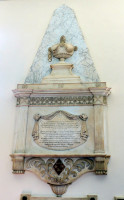
19th Century Monuments
The Hooker family:
William Hooker and his son Joseph Hooker were both long-time Directors of Kew Gardens,
and together with the more modest panel to Joseph Hooker’s wife, Frances,
form a colourful ensemble of botanically decorated monuments – the son’s monument takes us
into the 20th Century.
The Tyrrell Family:
There are half a dozen monuments to members of the family, spanning the middle half of the
19th Century, and we consider them first. Together, they form a representative selection
of the white-panel-on-black-backing type of monument, typically styled as a tomb-chest end,
with a pediment and little feet, and in the earliest two examples, additional sculptural ornament
to make more artistically interesting monuments; there is also one carved in the form of an
unrolling scroll.
- Timothy Tyrrell, d.1832, wife Elizabeth, d.1835,
son Charles, d.1832, an architect, and Juliana, d.1838,
wife of another son, George Tyrrell. Rather grand, the central panel bearing a pediment with
a low relief sunburst, with an urn on top, draped asymmetrically to fall in graceful folds
down the right hand side of the monument; on the left is carved a hanging, withered vine
which goes part way down. The overall composition is thus both balanced and asymmetrical. Below, a prominent shelf,
and two large brackets with fluting and little acanthus leaves carved at the bottom; in the central area
between them is a small coat of arms with a delicate border of carved flowers and ribbons.
Assured work by the prominent sculptor Richard Westmacott Junior, son of the more famous sculptor
Sir Richard Westmacott RA.
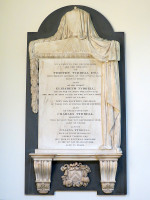
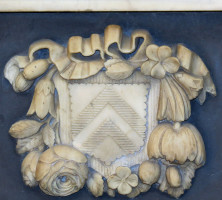 Timothy Tyrrell, d.1832, by Richard Westmacott Jr.
Timothy Tyrrell, d.1832, by Richard Westmacott Jr.
- John Tyrrell, d.1840, eldest son of Timothy and Elizabeth Tyrrell.
Panel with pediment above bearing a coat of arms and with acroteria at the corners.
With a narrow grey marble backing. Below, a separate panel between thick, plain pilasters,
with a relief carving of a bound book and various scrolls (see picture below left), illustrating his contribution as a lawyer,
appointed as a commissioner into property law and a Justice of the Peace for Surrey.
- Frederick, Tyrrell, d.1843, as a tomb chest end, with receding pilasters,
upper and lower shelf carved with a repeating motif, and symmetrical leaf designs on the feet.
Signed by the stonemason Bedford, of 256 Oxford Street, London.
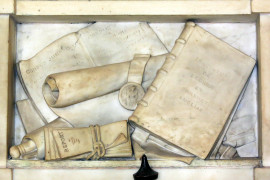
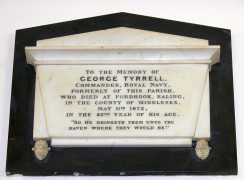
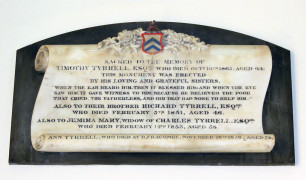
Smaller monuments to some other members of the Tyrrell family.
- Timothy Tyrrell, d.1865, brother Richard, d.1851,
Jemima Mary, wife of Charles Tyrrell, d.1853,
and added at a later date, Ann Tyrrell, d.1876. The white panel is in the form of a scroll,
curled backwards at the top, forwards at the bottom – it is the forward bit of this curve which bears
the brief inscription to Ann Tyrrell. At the top, a little shield of arms, painted, on a small mound
of plucked flowers and leafy branches, gracefully and delicately carved - see picture above right.
All on a narrow black backing, domed at the top.
- Frances Tyrrell, d.1870, and husband Edward, d.1881,
white panel with upper and lower shelf, the upper one including an entablature carved with
a leaf design. By the stonemason Adolphus Tagnon.
- George Tyrrell, d.1872, Commander RN, as a tomb chest end,
with prominent shelf, and little pineapple-feet, very crisply cut, on a black shaped backing - picture above, centre.
Other 19th Century Monuments
The most sculpturally interesting examples are the one to Sir John Day,
with a fine relief sculpture of a girl mourning by a flaming pot on a tomb,
and the excellent floral monument to Francis Bauer, and towards the end of the Century,
the Atkinson panel with two small bronze figures. Among the various simpler panels,
we have met several of the usual types in the Tyrrell family, above, and there are more
of these small Classical panels, and in addition a couple of examples based upon oval compositions.
- George Wilson, d.1804, of Symonds Inn, London, last in the line of a
hundred years of lawyers in Symonds Inn. With a long inscription. Plain white panel.
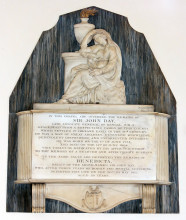
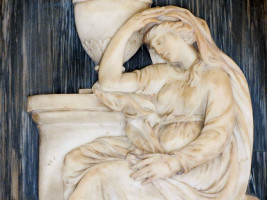
Sir John Day, d.1808, and detail of figure, by Sanders.
- Sir John Day, d.1808, Advocate General of Bengal, and wife
Benedita, d.1811. Panel with fluted receding sides, and on top, a fine carving
of a mourning female seated in front of a tomb with a pot on top. The pot is severely Classical,
and has a blowing flame on top (thus blowing out, indicating death), but the girl is more Hellenistic.
She is seated on some rock, her elbow on the edge of the tomb, her hand lightly touching her head
as she bows her head in sorrow, the line of her curved arm and hand followed through with a curved head
covering of drapery which swirls down over her back and curves up to her other hand and back to under
her elbow, thus giving a nice oval composition. One leg is stretched out, the other back,
giving opportunity for more nice drapery lines, including a hanging fold from the knee echoing the oval,
and minor repeating folds over the lower leg. At the base of the monument, two curled brackets
and a central coat of arms in low relief. The backing is in streaky grey marble.
The monument is signed by Sanders – it is open to question as to whether this is the same man
who signed the William Atton monument 15 years previously.
- Revd Thomas Cope Marsham, d.1817, and wife
Penelope Judith Marsham, d.1846. He was the vicar of St Anne for 16 years.
As a tomb chest end, with pediment bearing a sculpture of a dove flying downwards with a sunburst behind,
and graceful anemone acroteria ('ears'). The tablet is signed by T. Coles, of Portland Road.
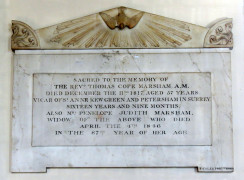
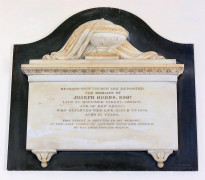 Revd. Marsham, by T. Coles, and J. Hobbs, by Bedford of Oxford St.
Revd. Marsham, by T. Coles, and J. Hobbs, by Bedford of Oxford St.
- Panel to George Engleheart, d.1829, miniature painter to George III,
nephew John Cox Engleheart, d.1862, and Sir J. Gardner Engleheart,
the latter’s son, d.1923. With side pilasters, large coat of arms under a little curved pediment
or canopy above, and a simple apron below with a rosette.
- Haverfield family: John Haverfield, d.1830, Justice of the Peace,
Lieutenant Colonel and Quarter Master General, and his brother
Revd. Thomas Tunstall Haverfield, d.1866, Rector of Goddington.
In the shape of a tray with handles on a black backing.
- Major Henry Wykeham Brook Tunstall Haverfield, d.1895,
grandson of John Haverfield on a neighbouring smaller panel, and a third one to
Lieutenant John Campbell Haverfield, d.1915, died in battle in Mesopotamia,
son of the Major. Both these panels are plain.
- Joseph Hobbs, d.1838, as a tomb chest end with delicate carving to shelf
and feet (see picture above right), and a small pot on top with asymmetrical drape. Signed by Bedford, of 256 Oxford St,
who also made the Timothy Tyrrell monument noted above.
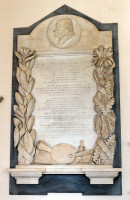
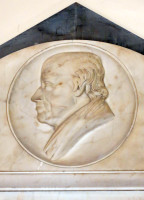
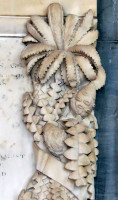
Francis Bauer, d.1840, and details, by R. Westmacott Jr.
- Francis Bauer, d.1840, botanical painter, with a long eulogy.
At the top, a rounded pediment enclosing a roundel with a portrait profile of the deceased in old age.
To left and right, instead of pilasters, there are carefully carved plants – broad-leaved on the left,
ferny and with some flower at the top on the right; beneath are carved the tools in trade of the
illustrator – palette and brushes, rolled and flat paper, a book, and a small microscope,
a speciality of Hauer’s. Signed by R. Westmacott Jr: we have met his work already in the
Francis Tyrrell monument.
- Jonathan Hiscock, d.1853, Parish Clerk of Kew for over 53 years,
the tablet being ‘erected by the Royal Family, Vicar, Curate, Gentry and Inhabitants of Kew’.
White panel with little legs, on a rectangular black backing; the text being in ornamental script.
- John Higgins, d.1853, ‘who held the united offices of Beadle and Herdsman
of this Parish upwards of twenty three Years.’ – oval plaque on a rectangular grey and
black marble backing, the text carved in a decorative script, with red for the capitals
and the name of the deceased.
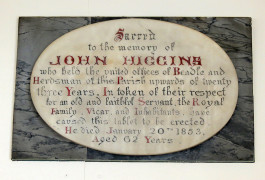
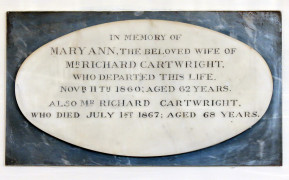
Higgins and Cartwright monuments, mid-Victorian compositions based on the oval.
- Lieutenant George Ross Caldwell, d.1859; a Dragoon guard who died at Sealkote,
Punjab. White tomb chest end with shelves above and below, coat of arms of the regiment carved on
the pediment, and a black backing. By Thomas Gaffin, of the prolific firm of London statuaries
based in Oxford Street.
- Mary Ann Cartwright, d.1860, and husband
Richard Cartwright, d.1867, simple oval plaque on a rectangular grey and white
streaky marble backing (see picture above right).
- Elizabeth Fennings, d.1862, daughter of Jonathan Hiscock, whose monument
we have noted above, a simple irregular pentagon as if a casket end.
- Thomas Gainsborough panel, noting that he was buried in the churchyard
(a plain ledger stone without ornament), put up by E. M. Ward, another painter,
though not of the eminence of Gainsborough, in 1865; Gainsborough of course had died in 1788.
Simple panel with a stone border with little bronze bosses at the corners.
- Revd. Richard Burgh Byam, d.1869, vicar, on a panel with chunky,
dominating upper pediment and lower shelf, with minor repeat-pattern carving and crucifix
on the pediment, all on a black backing. By Gaffin of Regent Street
– we met Thomas Gaffin above in the Caldwell monument.
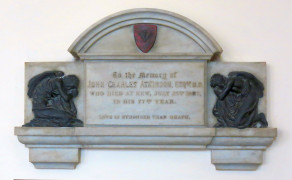 John Atkinson, d.1887.
John Atkinson, d.1887.
- John Charles Atkinson, d.1887. Panel with curved pediment on top
enclosing a small bronze shield at arms, shelf below with two brackets, and to left and right,
almost square panels with high relief bronze sculpture of kneeling, mourning angels, male and female.
An effective composition. Below this are two plain brass panels to
Edward Arthur Atkinson, grandson, d.1918 in action in Belgium, and to
Eliza Sarah Atkinson, d.1908,, the elder Atkinson’s wife.
20th Century monuments:
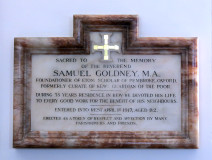 Revd. Goldney, d.1917, with alabaster surround and mosaic cross.
Revd. Goldney, d.1917, with alabaster surround and mosaic cross.
Modern brasses:
Also in the Church:
Outside the Church:
The Church has a small yard around it, raised up above the road, crowded with gravestones,
tomb-chests and caskets. The flat ledger stone to Gainsborough has been mentioned above;
the eminent painter Johanne Zoffany is also buried there.
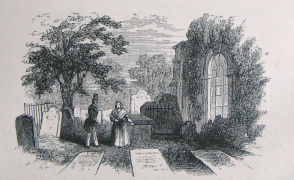
Gainsborough's tomb.
With thanks to the Church authorities for permission to use photos from inside St Anne's; their website is at
http://www.saintanne-kew.org.uk/twentytwelve/history01.html.
Top of page
Nearby, Twickenham Church // Mortlake Church // Richmond Church
Monuments in some London Churches // Churches in the City of London // Introduction to church monuments
Angel statues // Cherub sculpture //
London sculpture // Sculptors
Home
Visits to this page from 20 Feb 2015: 10,884







 Elizabeth, Countess of Derby, d.1717.
Elizabeth, Countess of Derby, d.1717.

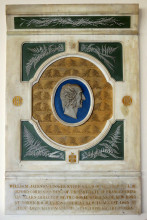
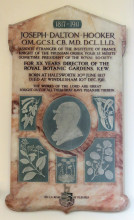
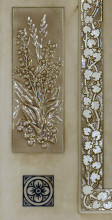




 Revd. Marsham, by T. Coles, and J. Hobbs, by Bedford of Oxford St.
Revd. Marsham, by T. Coles, and J. Hobbs, by Bedford of Oxford St.


 Revd. Goldney, d.1917, with alabaster surround and mosaic cross.
Revd. Goldney, d.1917, with alabaster surround and mosaic cross.